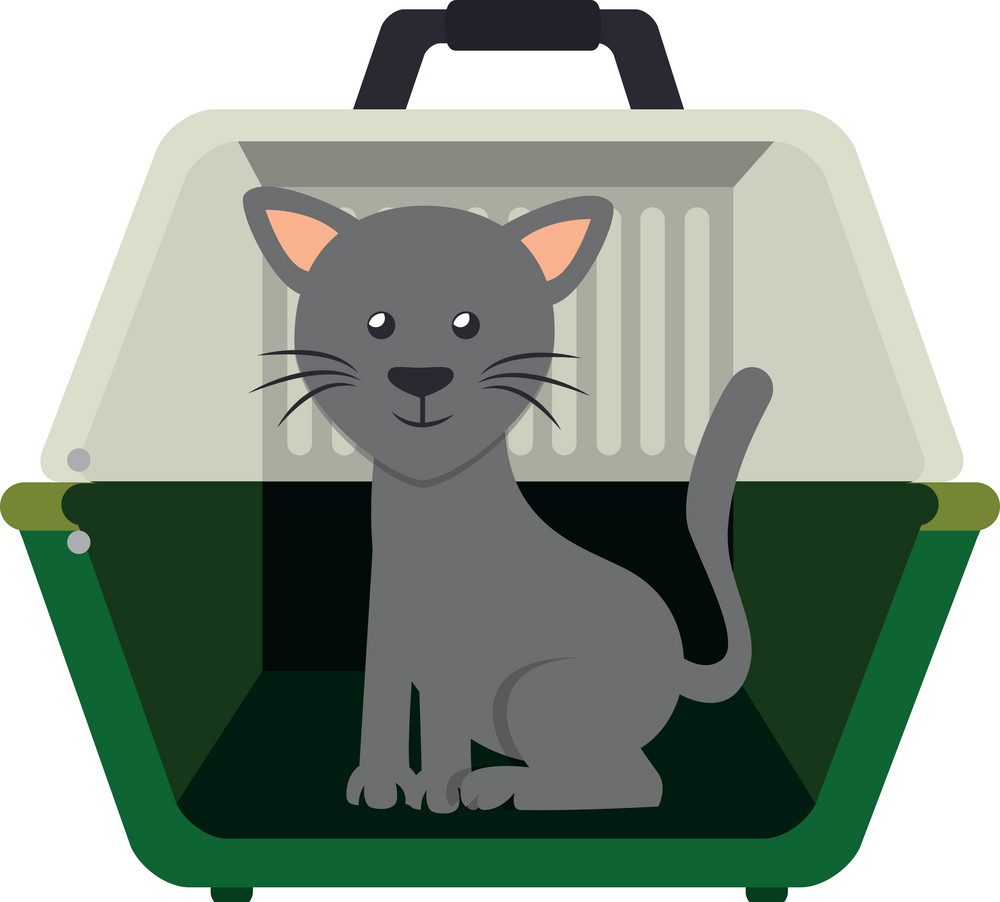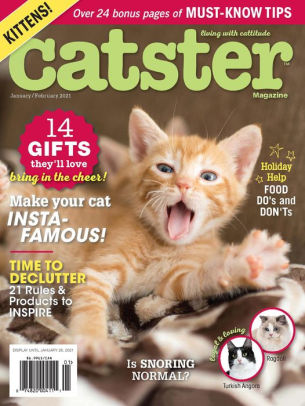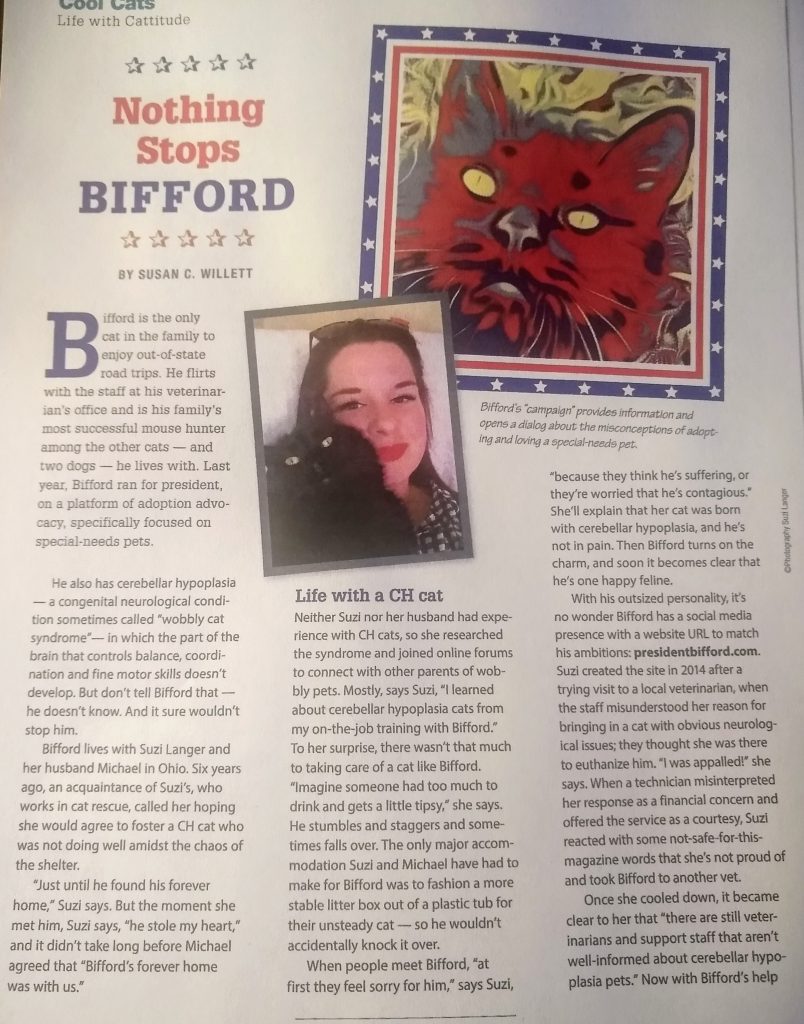Cats with Special-Abilities!

Blind Cats:
Loss of eyesight can be very gradual (or you adopted a blind kitty) and oftentimes owner’s do not realize how bad a cat’s eyesight has become until it is identified by your veterinarian. Blind kitties can adapt extremely well to the loss of eyesight and often compensate by using their other senses more.
What can cause blindness?
- Dry eye, as a consequence of feline herpesvirus or an eye injury
- High blood pressure results in the detachment of the retina, the light sensitive-tissue that lines the inner surface of the eye — often cause by an overactive thyroid gland or kidney disease. Blindness in this case is often very sudden in onset, though if they are taken to the veterinarian immediately, it can sometimes be reversed.
- Injury
- Glaucoma or increased pressure of the eye – as a consequence of an injury, tumor or inherited disease.
How can I help my blind kitty adapt?
If blindness is caused by disease or injury, one or both eyes may be removed. A cat that becomes suddenly blind can become easily disoriented. They may be unwilling to leave their sleeping area and may develop inappropriate bathroom habits because they are unable to find their litter box.
- Never, ever let blind cats roam outside, for their own safety! Keep your cat indoors unless they can have access to a safely-fenced garden or run. Make sure your kitties are microchipped and consider carefully fitting a quick-release harness/collar with your name/address on it and “special ability” in the event they escape!
- Be more aware to your cat’s indoor environment to keep things fun for them! Interactive toys and puzzle feeders can better help create interest for your blind cat.
Finding Their Bearings
Try to encourage your cat to walk around on their own, as carrying them may cause them to become disoriented! Cats have scent glands on their paws that allow them to leave behind a scent trail to follow — this is even more important for blind cats! If you do have to carry them, always put them down on a surface they are familiar with such as their feeding/sleeping area (this allows them to easily get their bearings about them). Beware of lifting a blind cat onto a raised surface as there is a chance they will fall and get injured. Using various textured surfaces in different areas can also help your blind cat get around.
Approaching Your Cat
Talk to your blind cat as you approach them to avoid scaring them. If your kitty is blind in one eye, try to approach them (while talking to them) from the side they have vision in.
Getting Around
As blind kitties rely on scent and memory to help navigate their way around, you should avoid moving furniture, food or litter box around. Don’t leave obstacles in unexpected places where your cat can walk into them and possibly get injured. If you have stairs, place a baby gate or barrier across them until your kitty knows where they are and learns to use them properly. Putting a different texture on the top and bottom steps can help your kitty quickly learn when to anticipate when they have reached the top or bottom stair. Whiskers become more important to blind cats to judge the cat’s distance to an object.
Play/Exercise
Sound is obviously very imperative to a blind at so they may enjoy playing with the “noisy” toys. It is important to encourage them to exercise as it is part of a cat’s natural behavior and will help them from becoming obese.
Moving House
Moving house with a blind kitty is similar to settling a sighted cat into a new home. However, blind kitties will need a little extra attention and should ensure that the new surroundings are safe. Supervise their adventures around the house until they seem confident. If they become disoriented, gently guide them back to a familiar place by using your voice or by walking with them.
Deaf Cats
Some kitties are born deaf, but many cats lose their hearing gradually as they age. Sudden loss of hearing is normally the result of illness/injury and may be temporary or permanent. Deaf kitties can compensate for their lack of hearing by using their other senses, so much so that it may be hard to tell whether or not they are deaf. There are varying degrees of deafness and various causes, which may or may not be treatable.
Types of Deafness
There are two primary types of deafness:
- Where the sound cannot pass into the ear due to;
- Tumors
- Outer & middle ear infections
- Wax build up
- Ear mites
The types of deafness detailed above may be reversible by treating the underlying causes with the guidance of your veterinarian.
2. Where the nerves associated with the ear do not function properly due to;
- Genetic problems (in the case of some white cats)
- Inner ear infections
- Drug toxicity
- Noise Trauma
- Age-Related Degeneration
These conditions generally produce permanent deafness.
How can I tell if my cat is deaf?
Some deaf kitties call out more often & more loudly – they cannot regulate their own volume – while others may become mute. It can be very hard to determined if a cat is deaf, espeically if they have been deaf from birth and is very used to their special ability, but other various signs may include:
- Failure to response when spoken to/called
- Easily startled
- Signs of dizziness/disorientation
- No longer being afraid of the loud noises (trash bags, sweepers etc.,)
- Shaking the head or clawing at the ear(s)
- Pus or other discharge coming rom the ear or an unpleasant odor from the ears.
How do I help my deaf kitty adapt?
A deaf kitty is easily startled because they won’t be aware that you are approaching. Make sure that you walk heavily when approaching them, so they can feel the vibrations. At close range, sharp hand claps or stamping on the floor may still be sufficient to gain a partially-deaf cat’s attention.
A deaf cat will not be able to hear danger signals such as cars or other animals so we strongly suggest keeping your cats indoors.
Deaf cats can learn to recognize hand signals or the flashing of a light. Make sure the signal you choose to call your cat is distinct and consistent so they do not get confused.
Three-Legged Cats
Some kitties are born with only three limbs, but the majority of three-legged kitties have suffered injury/disease, which has leg to amputation of the affected limb. Cats adjust to three-legged lifestyle remarkably well, although the initial adaptation process can be a little challenging. However, once adjusted, most three-legged cats are able to jump, climb, play, hunt albeit perhaps a little more slowly than in their four-legged days. Young cats and males are more prone to become three-legged — amputation is often result of traumatic injury, with males more likely to roam further than females and younger exploring cats more likely to be involved in road accidents. Most three-legged cats have lost a hind limb, rather than a fore limb.
My cat has had its leg amputated, how can I help them adjust?
- Confine your kitty to a room (for at least a week or so) or take advice from your veterinarian and follow any aftercare advice they may provide. Be sure to speak to your vet about the subtle signs of pain of pain in cats, as this may need managing in the post-operative period.
- Ensure there is easy access to food, water, litter box and a scratching post. Although cats don’t like to eat near their drinking/toileting area, immediately following surgery, your kitty is likely to appreciate these facilities being nearby.
- Other pets in the household may see a change. Cats rely on scent to identify the members of their social group and a stay at the vets can mean cats are not recognized when they return. It is prudent to reintroduce cats to one another slowly and only once the patient has had ample time to recover.
- Your cay may take some time to relearn how to balance with three limbs. Limit access to high surfaces and keep them indoors until they are more confident. Provide stools that can be used as steps to help your cat access things like the sofa.
- Move furniture closer together so it is not so hard to negotiate. As your kitty gets more confident and ability increases, furniture can gradually be moved back to its normal location.
- Be aware of litter box issues. Bathroom time is a vulnerable activity for a cat and if they do not feel safe using their litter box, they may choose to use the bathroom somewhere else within the house. You may need to provide a step to improve access to the litter box and be patient while they learn to cover, dig, and clean themselves with three legs instead of four.
- Your cat may appreciate help in grooming areas they have problems reaching due to difficulty balancing. If your cat is not used to being groomed, start very slowly and be sure to make the experience positive by offering praise/rewards
Do three-legged cats think their leg is still there?
Some cats will feel that they can still use their missing limb – for example, many cats missing a hind leg, will continue to try and scratch their ear with the missing limb, for the rest of their lives. It is not absolutely known whether cats are affected by phantom limb sensation which affects a high portion of human amputees, but they only rarely show signs suggestive of this.
Cerebellar Hypoplasia
Cerebellar Hypoplasia is a condition which occurs in kittens as a result of interrupted development of the brain leading to uncoordinated movement or ataxia. Affected kittens are often referred to as “wobbly kittens.” There can be many causes of ataxia, but this guide specifically addresses one of those causes – – cerebellar hypoplasia.
What causes cerebellar hypoplasia?
This occurs in kittens as a result of their mother being infected with a virus called feline parvovirus during pregnancy. It can also occasionally occur if the kitten is infected in the first few weeks after birth. Some or all of the litter of kittens may be affected and some individuals may be more affected than others. The virus affects the cerebellum during the kitten’s development and it is this part of the brain that is responsible for fine-tuning movements/mobility.
What are signs of cerebellar hypoplasia?
Wobbliness becomes evident when kittens first start to move at a few weeks of age but is non-progressive so does not worsen oer time. Cats are affects for the rest of their lives, and generally learn to cope with their condition. Affected cats may:
- Stand with their legs far apart
- Sway when they move
- Life their legs high when they walk or goose step
- Show nodding/head tremors, which may worsen when they focus to do something such as eating
- Lose their balance
Is there any treatment for cerebellar hypoplasia?
Once the cerebellum has been damaged in this manner, it cannot be repaired, so there is no treatment for cerebellar hypoplasia.
Does a cat with cerebellar hypoplasia require special care?
- Cats with CH appreciate a deep litter box with high sides that they can use for support to balance when going to the bathroom, but ensure the cat can get in and out of it without issue. A large box gives the cat plenty of space to move around inside it, and ensure it cannot be tipped.
- Affected kitties may be messy eaters- feed in an easily cleaned area and use a sturdy water dish that is not easily tipped over – for some kitties, raising bowls a little can be helpful
- Kitties with CH can find it difficult to accurately jump – provide easy ways to cats to access their favorite areas – cushions and rugs can act as “crash mats”
- Use a ramp to give an affected cat access to high surfaces (but be careful as they may tumble when trying to get down)
- Carpeting can provide extra grip for kitties walking around or climbing
- Keep their claws trimmed as it can be more difficult for them to “unhook” themselves if they get a claw stuck.
What is outlook for kittens with CH?
Most kittens are only affected mildly to moderately. With minor adjustments to their care they can enjoy a good quality of life. Occasionally, very severe kittens may be unable to perform without guidance, compassion, patience and constant care.





































